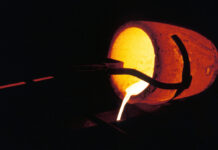
SIBANYE-Stillwater declared a final dividend of R9.4bn, equal to 321 South African cents a share, for its 2020 financial year, and said it would switch focus from debt reduction to capital allocation, starting with R6.8bn in platinum group metal (PGM) and gold projects approved by the firm’s board on February 16.
Commenting in its 2020 financial year-end announcement, in which it posted a record full-year attributable profit of R29.3bn, the company said it was now R3.21bn net cash as of December 31 and ready to invest in production growth.
This was following a year of blockbuster improvements in metal prices, PGMs especially where the basket price for platinum, palladium, rhodium, and gold was some 83% higher year-on-year, and bringing to an end a three-year period of high indebtedness dating from the firm’s foray into PGM production analysts said prevented the firm’s share from rerating.
New projects include the proposed 130,000 oz per year Burnstone, a gold mining development in South Africa’s Mpumalanga province, that Sibanye-Stillwater would spend R2.3bn completing. The other projects are the R3.9bn K4 platinum group metals (PGM) brownfields expansion at Marikana section (formerly Lonmin which sank R4.4bn into the project), and Klipfontein which is an extension of Sibanye-Stillwater’s Kroondal PGM mine, for a capital cost of R66m.
The K4 project would be brought into production in 12 months and reach sustainable annual production of 250,000 4E oz at an average operating cost of about R16,000/4E oz achieved in approximately seven years.
About 7,000 jobs would be created over the life of the three projects.
However, Sibanye-Stillwater CEO, Neal Froneman, issued a word of warning to the South African government of which he has been critical in the past.
“The commitment to invest approximately R6.8bn in the three major capital projects approved by the board should not be construed as a vote of confidence in the investment climate in South Africa,” Froneman said in comments to the published numbers.
He added that mining policy and the subdued nature of the business climate in South Africa was, in fact, a major deterrent to new investment at a time when “mumurings” of a commodity supercycle were growing in volume. Froneman previously said the company was seeking new investments in battery minerals and gold outside South Africa.
Sibanye-Stillwater identified a number of other, as yet unapproved, new ventures including shaft developments and extensions at Marikana (East 3, M5 project, East 4) and Rustenburg’s Siphumelele 1 shaft development and UG2 extensions. The Bloemhoek project adjacent to the Beatrix mine in South Africa’s Free State and secondary reef projects at Driefontein and Kloof were gold projects also in the offing.
DIVIDENDS
Political and regulatory misgivings notwithstanding, Sibanye-Stillwater registered its best profit-making year since inception.
Normalised earnings, which strips out exceptional items such as foreign exchange movements and impairments among other things, was a record R30.6bn (2019: R2.4bn), and at the top end of the range as indicated in a February 5 trading statement.
The full-year dividend, after a somewhat conservative 50 SA cents interim dividend, was R371 cents or R10.7bn. In US cents this was $25.15c or $100.6c per ADR. The payout represented a dividend yield of about 6% at the prevailing share price. On a 12-month basis, shares in Sibanye-Stillwater were trading 57% higher at the time of writing.
Commenting on prospects, Froneman said that increased substitution of palladium with platinum would see the long-standing supply surplus in the latter vanish by 2024. A supply deficit in palladium would continue, also into 2024.
Froneman offered few clues, however, as to the group’s attitude towards renewed merger and acquisition activity. He has mentioned in the past an interest in accessing the battery mineral supply market including metals such as copper, nickel, and lithium, possibly through a smaller-scale downstream investment.
Said Froneman today: “With the medium term evolution of the automobile drive train from internal combustion engines (ICE) to greener technologies, such as battery electric, fuel cell electric and hybrid vehicles, we continue to monitor and evaluate the sector for entry points that meet our strategic objectives”.











